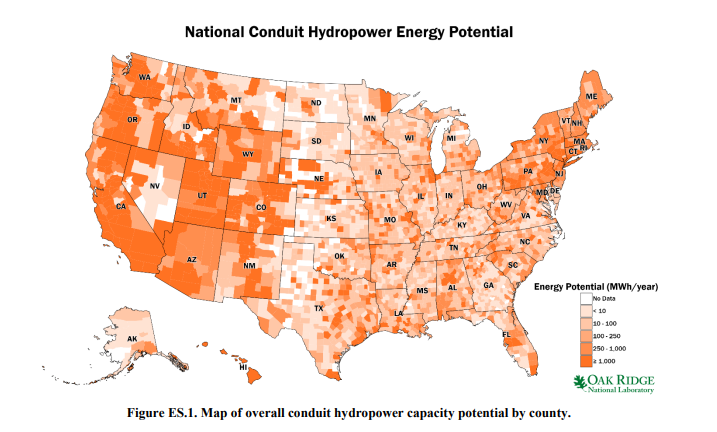Existing Water Infrastructure Could Maximize Hydropower Opportunities
Researchers from the U.S. Department of Energy’s Oak Ridge National Laboratory have determined that using conduit hydropower could increase renewable energy generation within existing infrastructure.
In the past few decades, solar and wind power use has dramatically increased in an attempt to expand access to renewable energy sources. However, hydropower, considered the most extensive global renewable, has fallen behind the alternatives due to a lack of infrastructure expansion in the United States. Researchers from the U.S. Department of Energy’s Oak Ridge National Laboratory are working to enhance the existing water infrastructure’s efficiency by using conduit hydropower in all 50 states where there is sufficient water flow and hydraulic head.
Hydropower has fallen behind as a renewable energy resource in the United States. Image used courtesy of DOE
Hydraulic Head the Key to Effective Conduit Hydropower
The flow of water is influenced by differences in potential energy, most often visible in surface water by a clear elevation drop that pulls water downward from high potential energy to low potential energy. However, in groundwater systems—the more common placement for the conduit hydropower system—the potential energy driving water flow is associated with pressure changes. This is measured by proxy using the hydraulic head: the measure of pressure above a vertical datum. For conduit hydropower to be effective, there needs to be excess hydraulic head.
Hydraulic head in a hydroelectric dam. Image used courtesy of Energy Education
At a location with a higher hydraulic head, a higher amount of energy in the water moves through that conduit, generating more hydropower. This is important in order to have significant energy generation without detracting from the energy needed to move the water.
Vast Potential for Conduit Hydropower Expansion
According to the Oak Ridge Laboratory report, a conduit is any man-made water transport system—such as an irrigation canal, aqueduct, or similar structure—not primarily intended for electricity generation. Currently, U.S. conduit hydropower capacity is about 530 megawatts, but the Oak Ridge researchers see an opportunity for considerable expansion across all 50 states.
National conduit hydropower energy potential by county. Image used courtesy of Oak Ridge National Laboratory
By utilizing existing water infrastructure, there is an opportunity to harvest otherwise unexploited energy. An additional 1.41 gigawatts of electricity is expected to be sent to the power grid each year by installing conduit hydropower; this is enough electricity to power more than one million homes.
Shih-Chieh Koa, the water power program manager at Oak Ridge, believes conduit hydropower is a simple first step. The challenge is spreading awareness of the potential for renewable energy growth. One of the benefits of conduit hydropower is that the systems don’t require new construction to operate. With cities and businesses on board to employ the projects, installing the hydropower generators could be coordinated with planned infrastructure upgrades, or replacements, especially to enhance energy efficiency of the systems.
Based on an analysis of four types of conduit—water supply pipelines, wastewater discharge, irrigation systems, and thermoelectric cooling—and topography to determine water flow and hydraulic head, the highest potential for conduit hydropower was determined to be in California, Colorado, Washington, Nebraska, and Oregon. These five states have the greatest hydraulic head because of hilly terrain and plenty of water conduits.
Agricultural Sector Best for Conduit Hydropower Growth
Among the three business sectors—municipal, agricultural, or industrial—opportunities for conduit hydropower are greatest in agricultural conduits such as ditches or channels due to irrigation and topography.
Drinking water and wastewater systems show the greatest capacity for the municipal sector; pipelines and canals at thermoelectric facilities have the greatest capacity for industrial conduits. Understanding where the greatest potential for conduit hydropower exists helps stakeholders use existing infrastructure for the best opportunity to expand renewable energy generation.
Conduit hydropower is expected to have little environmental impact because the projects typically are not within natural streams, dams, or reservoirs, and do not increase greenhouse gas emissions. This helps streamline any permitting process to install the systems, with approval in as little as 45 days. Thus far, 350 conduit hydropower projects have been approved or constructed.









